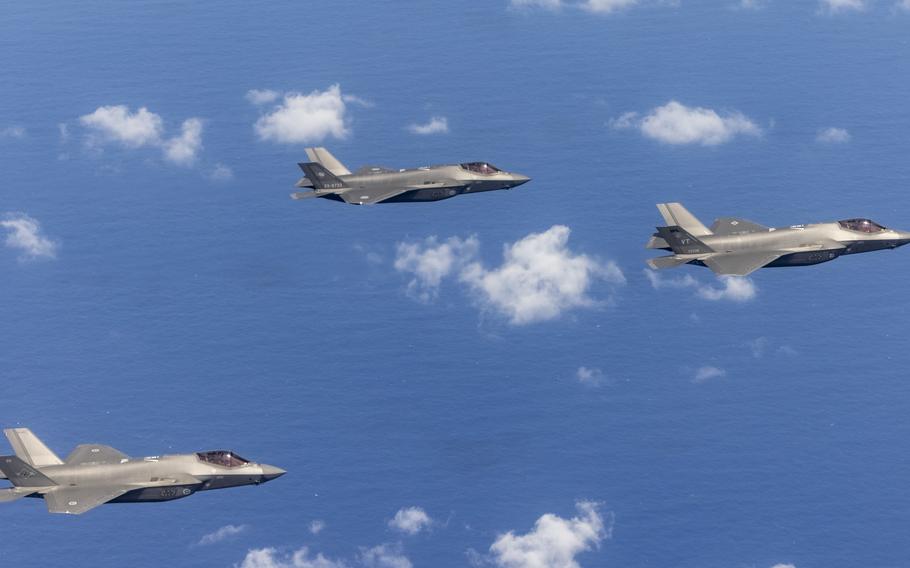
F-35 Lightning II advanced fighters from Australia, Japan and the United States fly in formation over the Pacific Ocean during exercise Cope North at Guam on Feb. 7, 2025. (Chloe Johnson/U.S. Marine Corps)
Potential U.S. adversaries will take note of unprecedented air power drills underway over Guam by 33 American, Australian and Japanese fifth-generation fighters, a retired U.S. Air Force lieutenant general said Friday.
Ten U.S. Air Force F-35A Lightning II fighters, nine U.S. Marine Corps F-35Bs, eight Australian air force F-35As and six Japan Air Self-Defense Force F-35As are part of Cope North, running until Feb. 21 from Andersen Air Force Base, Guam.
The drill shows the “maturity of the F-35 weapons system, and of the alliances,” said Dan Leaf, the former deputy commander of what is now called Indo-Pacific Command. “Two U.S. services, three countries, two models of the jet, coming together to build readiness and interoperability.”
It’s an unprecedented show of force, Leaf said by email.
“If I were an adversary considering taking this team on, I would think again,” he said.
The U.S. F-35As are with the Vermont National Guard’s 134th Fighter Squadron, according to email Friday from Air Force spokesman 2nd Lt. Codi Clemmons. The Vermont unit is doing a rotational deployment at Kadena Air Base, Okinawa, Japan, as the 134th Expeditionary Fighter Squadron.
The F-35Bs belong to Marine Fighter Attack Squadron 121, based at Marine Corps Air Station Iwakuni, Japan, Clemmons said.
More than 2,300 U.S. personnel are on Guam for Cope North along with 62 American aircraft, including F-16 Fighting Falcons, F-18C/D Hornets and EA-18G Growlers, along with command and control aircraft, refuelers, airlifters and helicopters, according to Pacific Air Forces.
Japan has sent two E-2D Advanced Hawkeye command and control planes and a KC-46A Pegasus tanker to the exercise, according to the Japan Air Self-Defense Force.
Australia’s defence force has sent 275 aviators, a KC-30A multi-role tanker transport and an E-7A Wedgetail airborne early warning and control aircraft.
Group Captain Darryl Porter, commander of the Cope North Australian contingent, in an emailed statement Wednesday said the exercise advances the commitment in May by Australian, Japanese and U.S. defense chiefs to train with F-35s in all three countries.
Col. Takeshi Okubo, a Japanese flight group commander at the exercise, in a Feb. 7 PACAF news release said the training prepares airmen to fight alongside each other. “And together we are an active deterrence to conflict,” he said.
It’s important to learn the small differences between how each nation employs, maintains and commands and controls the high-tech jets, according to Col. Charles Schuck, commander of the 3rd Wing at Joint Base Elmendorf-Richardson, Alaska.
“We’ll never learn those differences without actually exercising together,” he said in the news release. “Fifth generation fighters are the forward edge of our fighting force, especially in the Indo-Pacific, so it’s important to practice together with all the nations that fly them.”